Hyundai’s Ioniq 6 review: something old and familiar trying to act young, hip and cool
Beyond the Ioniq 6's glitzy gizmos there’s a very good car underneath. Perhaps not a great one, and not one that can really take the battle to the Model 3.
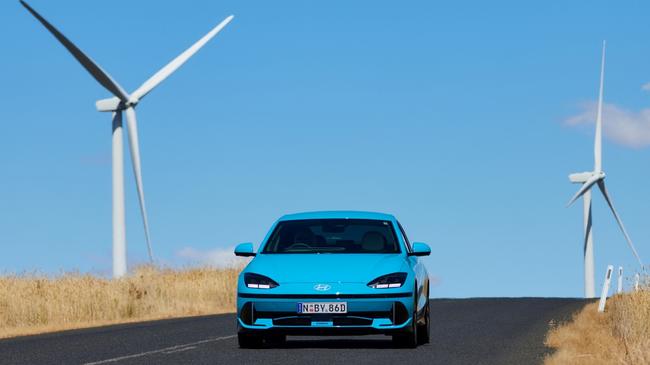
Hyundai’s new Ioniq 6 reminds me of Steve Buscemi, the American actor famous for his roles in iconic films such as Fargo, Big Lebowski and Reservoir Dogs.
Specifically, the Ioniq 6 reminds me of Buscemi’s now famous appearance in the television show 30 Rock, when he played a police officer who unsuccessfully goes undercover at a school, attempting to blend in with the teenage students despite being more than 50 years old.

“How do you do, fellow kids?” he says, while carrying a skateboard and wearing a t-shirt with ‘Music Band’ written across the chest.
Why does this scene spring to my mind with the Ioniq 6? Because that’s what this new electric ‘streamliner’ from Hyundai feels like - something old and familiar trying to act young, hip and cool.
The Tesla Model 3 is Hyundai’s clear and stated target for this new machine, which joins the Ioniq 5 SUV in an expanded range of electric vehicles for the brand.
The long-established South Korean car maker clearly sees the American upstart as the leader of the EV pack - at present. But for all of its high-tech powertrain and cutting-edge battery technology (more of which we’ll get to later) Hyundai is very keen to push the ‘cool factor’ of the Ioniq 6.
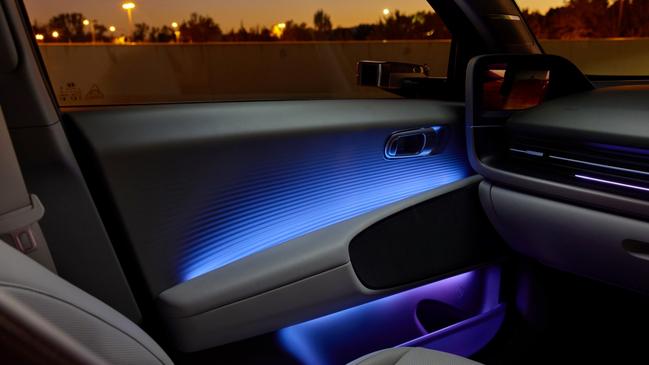
It has dual-colour ambient lighting (‘Speed sync lighting’ that can intensify the colour of the ambient lighting as you accelerate), ‘Relaxation front seats’ that can recline while you’re charging, and even the four small dots on the steering wheel can change colour.
Why exactly the dot lights need to change colour is unclear. As is the reason Hyundai has ditched its ‘H’ logo in favour of the dots, which, aside from connecting to the ‘pixel’ exterior lighting, also represent the letter ‘H’ in morse code - because nothing says cutting-edge, modern technology quite like a telecommunication system that dates back to the early 1800s…
To Hyundai’s credit, it didn’t start this arms race of trivial flashy lights and toys, Tesla did that with its own largely pointless array of gimmicks. And if that’s what people want, then car makers - especially legacy brands like Hyundai - need to react and adapt.
Looking beyond all these glitzy gizmos there’s a very good car underneath it all. Perhaps not a great one, and not one that can really take the battle to the Model 3 at present, but the Ioniq 6 is an EV with a lot of appeal.
Like the Ioniq 5, it’s built on Hyundai’s latest and greatest EV platform - the ‘e-GMP’ - which features a state-of-the-art 800-volt electrical system for improved range and faster charging.
The obvious difference between the Ioniq 5 and 6 are the shapes, with the former opting for an angular, edgy and contemporary design, while this new addition very much lives up to the ‘streamliner’ billing.
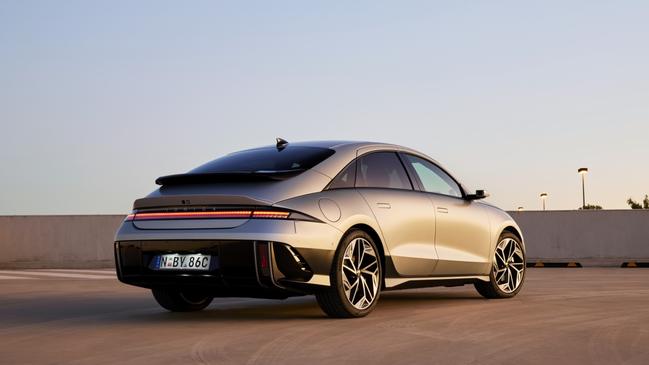
The Ioniq 6 features what Hyundai calls a ‘single-curve exterior shape’ with ‘carefully crafted contours’. Whatever you call it, this is a design shaped by the wind, with Hyundai trying to reduce drag through the air for improved range.
It seems to work, too, with the Ioniq 6 managing a longer claimed driving range than its boxier, SUV sibling.
Hyundai is offering two powertrain options in Australia, a single-motor, rear-wheel-drive model and a dual-motor, all-wheel-drive set-up. The former can reportedly travel up to 614km on a single charge under the right conditions, while the dual-motor can manage 519km. In comparison, the equivalent Ioniq 5 models manage 507km (RWD) and 454km (AWD).
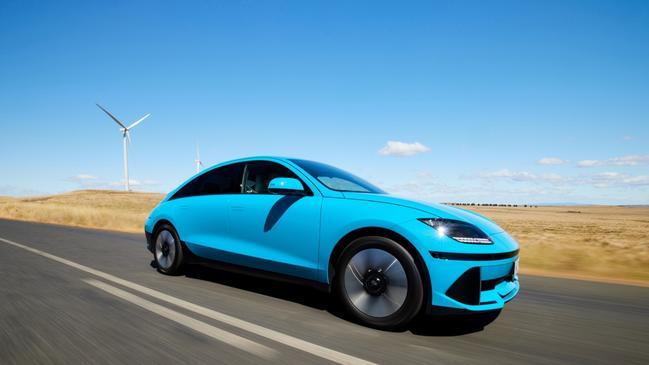
That does position the Ioniq 6 well against the Model 3, which manages 491km claimed range from its rear-wheel-drive model and 612km for its ‘Long Range AWD’ offering.
On the road the Ioniq 6 is brisk without being mind-bendingly fast, with the single-motor version making 168kW of power and 350Nm of torque, while the dual-motor bumps those figures up to 239kW/605Nm.
Frankly, Tesla’s obsession with 0-100km/h times is largely meaningless in the real-world (unless you want to make your passengers car sick by violently accelerating away from every stop), so the balance of performance and range from Hyundai is a welcome one.
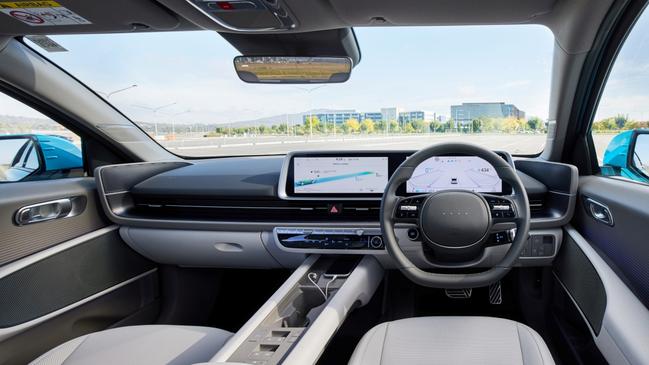
And for all the fancy lighting in the cabin, the Ioniq 6 biggest strength is clearly its space. At 4.8 metres long this isn’t a small sedan and it offers up generous room for the front seat passengers. Those in the rear get plenty of legroom too, limousine levels of space, but the headroom compromised by the ‘single-curve’ roofline; so anyone over 180cm will probably be brushing the roof.
The biggest obstacle Hyundai faces in taking on Tesla is the lack of supply, with the local operation expecting only 1000 examples of the Ioniq 6 to make their way to our shores in 2023.
Tesla is averaging more than 2500 Model 3 deliveries every month, so don’t expect to see a real challenge until Hyundai can build more Ioniqs and get them down under.
This restricted supply ultimately creates another problem - the price. Hyundai Australia has opted for a high level of standard equipment across the three-model range - Dynamiq, Techniq and Epiq - which means a higher asking price. The Dynamic RWD starts at $74,000, which is nearly $10,000 more than the entry-level Model 3, while the Techniq AWD starts at $83,500 and the Epiq AWD from $88,000.
While Hyundai may come across as trying a bit hard to capture the ‘cool kids’ with some elements of the Ioniq 6, there’s no doubt it’s an impressive electric sedan that will appeal to those looking for an EV from a brand with experience and a track record of quality.
Experience and a track record of quality? Sounds like Steve Buscemi.
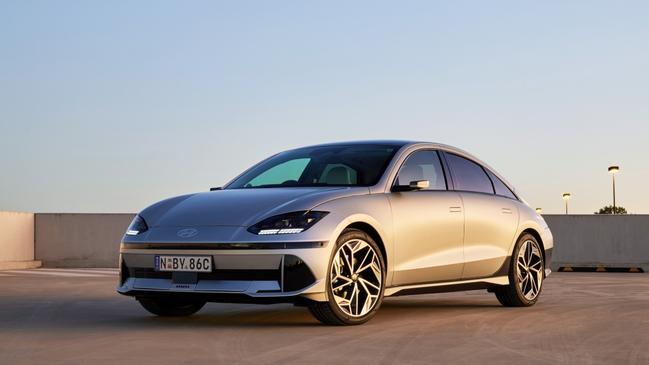



To join the conversation, please log in. Don't have an account? Register
Join the conversation, you are commenting as Logout